|
|
Book vs. Movie: RoomBy Ben GruchowFebruary 4, 2016
That first half, though, is just about unimpeachable. One of the biggest obstacles of this adaptation had to have been interpreting what is narrated to us in written form as a limitless world in a concrete, very limited visual sense. What the movie’s director Lenny Abrahamson and cinematographer Danny Cohen have done is utilize focus, exposure, and point of view to deny us a definitive sense of Room’s scope and size for as long as possible. Given that the set (and Room itself) is only about ten feet by ten feet in size, they succeed to a remarkable degree. This direction is paired with Jacob Tremblay’s voiceover, narrating Jack’s perception of Room and the world in several passages that are lifted almost directly from the novel. The elliptical nature of this narration not only works better than you’d expect, but it actually acquits itself more comfortably in the cinematic sense than it does in the written sense. Witness the passage of a normal day in the Room life of Ma and Jack - a breakfast of counting cereal pieces, physical exercise of going from one side of Room to the other, of jumping up and down and screaming up at Room’s skylight, which provides the sole source of sunlight. This is very loyal in a strict sense to the book, but it’s stunning how Abrahamson manipulates our perception of space and re-contextualizes Room according to each activity, while also never trying to hide what a limited space we’re working with.
|

|
|
|

|
Friday, May 3, 2024
© 2024 Box Office Prophets, a division of One Of Us, Inc.


